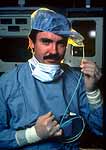| << To Blog Home >> | |
|
|
January 17, 2009 -- 19:30 EST FAME: "Back to the Future" Well...it's not a new device; it's definitely not a new concept; and St. Jude doesn't exactly get the credit for it either, since their chief role was to acquire the company that created the product. But it is an important study! First off, read Angioplasty.Org's article on the FAME study, which clarifies some of this; then read my exclusive interview with the FAME study's co-principal investigator, Dr. Nico Pijls.
Gruentzig continually monitored the pressure gradient during procedures and, when the distal and proximal pressures were similar, due to the dilatation or expanding of the balloon and compression of the plaque, he judged the procedure finished. Optimal dilatation of the stenosis had been achieved! Gruentzig was also very conservative regarding the ability of angioplasty to achieve a result. He called dilatation "a controlled injury" of the artery and was adamant that the decision to intervene needed to be made with great care and understanding of the downsides of the procedure. In these early days, the measurement of pressures required a separate lumen, which made the balloons were pretty wide and unable to get into narrow arterial spaces. Then Dr. John Simpson invented a much thinner balloon catheter: he got into the narrow spaces, but he sacrificed the ability to measure pressures. Gruentzig was not entirely comfortable with this "advance". But unfortunately he died in a plane crash in 1985, and well.... Fast-forward to the 21st century. For two decades, angioplasty has been done without monitoring the procedure with pressure gradients. Decisions were made primarily by eye (a.k.a. the oculo-stenotic reflex): there's a narrowing there; let's put in a stent. Now, thanks to Dr. Nico Pijls and others, cardiologists can measure pressures with a guide wire, using Doppler sensors et al. We are now able to measure gradients and make intelligent, data-based decisions about whether or not to dilate a blockage. The results? Well, don't intervene on a lesion/blockage that is not significant. It may do more harm than good. Gruentzig would have said the same. And now the FAME study reaffirms what he already knew, but which has been forgotten through the years. Back to the Future! |
|


 OK.
Now, let's get in the time machine and return to the genesis of coronary
angioplasty. It's 1977 and Andreas Gruentzig
has fashioned
a balloon catheter to open a blockage in a patient's
coronary artery. The balloon, which he is holding in the picture
to the left, not only can open a blockage in a coronary artery but,
oddly enough, also has the capability of measuring the blood
flow or pressure at the proximal and distal
ends of the
stenosis (a.k.a. "blockage"). If
the blockage is significant, the two pressures are widely divergent,
demonstrating that there is a diminished blood flow through this
arterial segment. These "pressure gradients" would be displayed
on the monitor behind him, if there were an actual procedure
going on.
OK.
Now, let's get in the time machine and return to the genesis of coronary
angioplasty. It's 1977 and Andreas Gruentzig
has fashioned
a balloon catheter to open a blockage in a patient's
coronary artery. The balloon, which he is holding in the picture
to the left, not only can open a blockage in a coronary artery but,
oddly enough, also has the capability of measuring the blood
flow or pressure at the proximal and distal
ends of the
stenosis (a.k.a. "blockage"). If
the blockage is significant, the two pressures are widely divergent,
demonstrating that there is a diminished blood flow through this
arterial segment. These "pressure gradients" would be displayed
on the monitor behind him, if there were an actual procedure
going on.